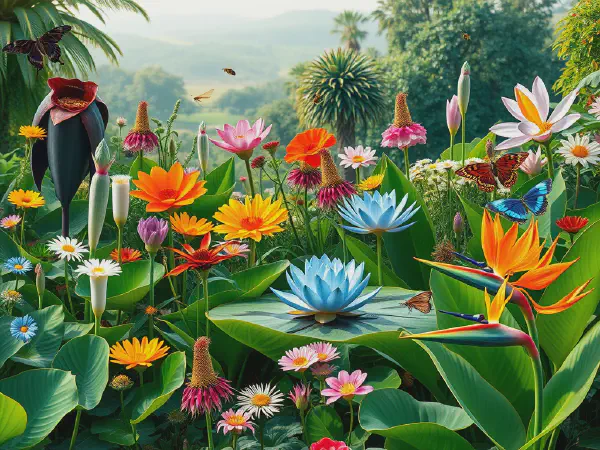Exploring the Unique Types of Flowers: A Complete Guide

Exploring the Diverse Types of Flowers
Flowers are among the most beautiful gifts nature offers, and the types of flowers are abundant and diverse, each with its unique features and significance. From stunning blooms in gardens to delicate petals in perfumes, flowers play an integral role in our lives and ecosystems. Understanding the different types of flowers helps us appreciate their beauty and the roles they play in our environment.
In this article, we will explore various types of flowers, categorizing them into common varieties, wildflowers, indoor flowering plants, edible flowers, and flower arrangements. Each category presents a fascinating insight into the vast world of florals, showcasing their beauty, purpose, and the joy they bring to our lives.
Flowers not only enhance our surroundings but also hold deep meanings and symbolism. They are used in celebrations, decor, and as gifts to express emotions. The right flower can convey love, friendship, sorrow, or joy. Understanding the types of flowers and their significance can help you make more thoughtful choices in your floral selections.
Whether you're a gardening enthusiast looking to enrich your garden, a nature lover exploring wild vintage blooms, or a culinary adventurer eager to experiment with edible flowers, the fascinating world of flowers offers something for everyone. Let’s delve into the captivating types of flowers and explore their characteristics and uses.
Join us as we embark on an exploration of floral diversity, diving into the rich array of types of flowers that capture our hearts and enrich our environment.
Common Types of Flowers
One of the most beloved types of flowers is the rose, which comes in a myriad of colors, each carrying its own meaning. For instance, red roses signify love and passion, while yellow roses often represent friendship and joy. Understanding the different colors and their symbolism can help you choose the perfect rose for any occasion.
Lilies are another popular type of flower, known for their elegance and fragrance. There are various species of lilies, including Asiatic, Oriental, and trumpet lilies, each offering unique beauty and care requirements. These flowers thrive in well-drained soil and benefit from regular watering and sunlight, making them a cherished addition to gardens and floral arrangements alike.
Daisies are cheerful flowers that symbolize purity and innocence. They are often used in bouquets and as decorative elements in various settings. Daisies are versatile and easy to grow, making them a staple in flower gardens. Their simple beauty and bright appearance make them a favorite among flower enthusiasts.
Tulips are well-known spring flowers that come in various seasonal varieties and colors, each with unique charm. They require well-drained soil and should be planted in the fall to bloom beautifully in the spring. Tulips are a classic choice for spring gardens and floral displays, representing renewal and the arrival of warmer weather.
Wildflowers
Wildflowers are native flower species that grow spontaneously in various environments. They contribute to biodiversity and often require minimal care. Popular examples include bluebells, poppies, and coneflowers, which provide beautiful colors and textures to natural landscapes. Each wildflower species has unique characteristics tailored to survive in specific ecosystems.
Wildflowers offer numerous environmental benefits, such as attracting pollinators, providing habitats for wildlife, and preventing soil erosion. They play a critical role in supporting local ecosystems and maintaining ecological balance. Integrating wildflowers into gardens or landscapes can enhance biodiversity.
Identifying wildflowers can be a rewarding experience, involving observation of flower shapes, colors, and foliage. Using field guides or mobile apps can assist in recognizing different species in their natural habitats. Understanding their characteristics also promotes appreciation for wildflower diversity.
Cultivating wildflowers at home is an excellent way to support local flora and fauna. You can choose native wildflower seeds that require little maintenance and are well-adapted to your local climate. A wildflower garden can provide a beautiful and sustainable environment while contributing to the ecosystem.
Indoor Flowering Plants
Indoor flowering plants can bring color and life to any interior space. Some of the best flowering plants for indoors include African violets, peace lilies, and orchids. These plants thrive in indoor conditions, offering striking blooms and improving indoor air quality.
Caring for indoor plants involves ensuring they receive appropriate light, water, and nutrients. It's essential to place them in suitable locations and monitor their growth regularly to maintain their health and vibrancy. Knowledge about each plant's specific needs can enhance their growth and flowering potential.
Popular indoor flowers like jasmine and hibiscus are loved for their delightful fragrances and vibrant blooms. Incorporating these plants can create a beautiful indoor environment, enhancing decor while promoting well-being.
Some flowering houseplants are specifically suited for low-light environments, making them ideal for areas with minimal natural light. Plants like snake plants and cast-iron plants are hardy choices for individuals looking to add greenery indoors without direct sunlight.
Edible Flowers
Edible flowers are a surprising category of flowers that can enhance culinary experiences. Common types include nasturtiums, pansies, and violets, each offering unique flavors and colors. Edible flowers are gaining popularity in gourmet cuisine, adding aesthetic appeal and flavor to dishes.
Health benefits of edible flowers are numerous; they are often rich in vitamins, antioxidants, and essential oils. Consuming these flowers can contribute to overall wellness and enhance the nutritional value of meals.
Incorporating edible flowers in cooking can transform everyday dishes into culinary masterpieces. They can be used in salads, desserts, and drinks to add color and flavor. Creativity in the kitchen can lead to delightful presentations and surprising tastes.
Popular recipes using edible flowers include lavender-infused syrups, flower petal salads, and herbal teas. Exploring these recipes can introduce new flavors and experiences, elevating your culinary skills.
Flower Arrangements
Flower arrangements come in various styles and types, including bouquets, centerpieces, and wreaths. Each arrangement serves different purposes, whether for decoration, gifts, or special occasions, showcasing the art of floral design and creativity.
Choosing the right flowers for arrangements involves consideration of color, shape, and texture. Mixing different types of flowers can create visually appealing compositions that enhance the overall effect of the arrangement.
Seasonal flower arrangement ideas can incorporate blooms that are at their peak during specific times of the year. Spring flowers like daffodils and peonies or summer blooms like sunflowers and hydrangeas can define seasonal aesthetics and themes.
Tips for long-lasting bouquets include trimming stems at an angle, changing water regularly, and placing arrangements in a cool area away from direct sunlight. These simple practices can extend the life of floral displays, allowing their beauty to shine longer.
